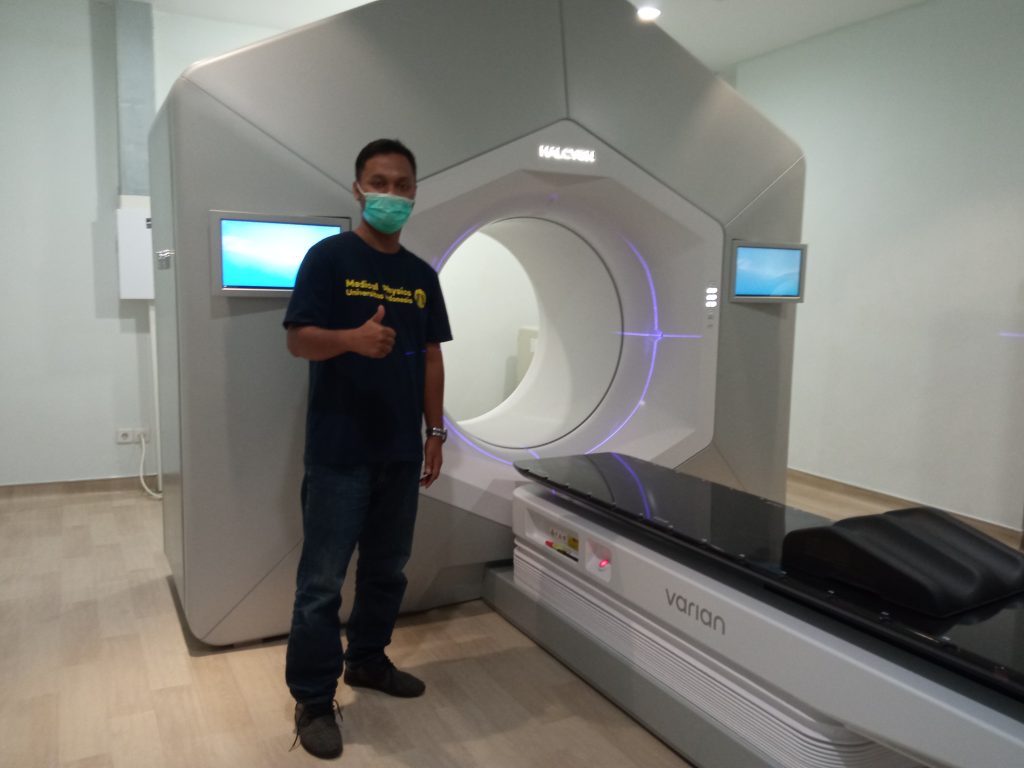
Hanendya Disha Randy Raharja, S.Si, is an alumnus of the Bachelor’s Degree Program in Physics, Class of 2011, at the Faculty of Mathematics and Natural Sciences, Semarang State University. During his time as a student, the author was actively involved in the student organizations of the Faculty of Mathematics and Natural Sciences Student Senate and the University Student Senate. The author has previously worked as a nuclear security analyst assistant at the Directorate of Radiation Facility Inspection and Radioactive Substance of the Nuclear Energy Regulatory Agency (BAPETEN) from 2017 to 2020, and is currently pursuing professional education as a medical physicist in Batch VII at the University of Indonesia. The author also holds the position of Level 2 Radiation Protection Officer in the Medical Radiation Protection Field.
Introduction
One of the branches of applied physics that applies the theories, concepts, and methods of physics principles and laws to clinical medical applications is Medical Physics. It all started with the discovery of X-rays by Wilhelm Conrad Röntgen in 1895, and since then, X-rays have been used in the field of medicine for diagnostic purposes. In recognition of the beneficial discovery of X-rays for humanity, Wilhelm Conrad Röntgen was awarded the Nobel Prize in Physics in 1901.
As one of the ionizing radiations, X-rays have the property of penetrating matter (the human body), making them useful for obtaining imaging of organs and tissues within the body. Additionally, high-energy radiation from ionizing radiation sources such as linear accelerators and radionuclides can be used for patient therapy, specifically for killing cancer cells. Ionizing radiation sources have the potential to cause organ damage at the DNA and cellular level (radiobiological effects), including deterministic and stochastic effects, as they can ionize the matter they pass through. On the other hand, non-ionizing radiations such as radio waves, microwaves, infrared, visible light, and ultraviolet rays are unable to ionize matter and are therefore not harmful.
While the interaction of ionizing radiation sources provides benefits, it also has the potential to have adverse effects on humans. To ensure the safety of workers, the general public, and the environment by preventing deterministic effects and reducing the potential for stochastic effects, radiation protection officers are responsible for creating protocols. Additionally, medical physicists play a significant role in healthcare facilities.
Services provided in healthcare facilities that involve diagnostic and interventional radiology (X-rays, CT scans, fluoroscopy, mammography, panoramic radiography), radiotherapy (linear accelerators, brachytherapy), and nuclear medicine (PET, SPECT, therapy) are closely related to the application of physics. Therefore, the role and contribution of medical physicists are highly valued. International Atomic Energy Agency (IAEA), World Health Organization (WHO), International Labour Organization (ILO), and International Organization for Medical Physics (IOMP) recommend the importance of medical physicists, as they are included in the requirements for obtaining permits for the use of diagnostic and interventional radiology, radiotherapy, and nuclear medicine from the Nuclear Energy Regulatory Agency (BAPETEN) in terms of human resources. As a result, the profession of Medical Physicist has become more widely known to the general public.
The Ministry of Health also recognizes the profession of Medical Physicist as a healthcare profession in accordance with Law No. 36 of 2014 regarding Healthcare. According to Article 11, Paragraph 12 of Law No. 36 of 2014 regarding Healthcare, the types of healthcare professionals included in the biomedical engineering group, as mentioned in Paragraph (1), Letter k, consist of radiographers, electromedical technicians, medical laboratory technologists, medical physicists, radiotherapists, and orthotics and prosthetics specialists. The professional organization that oversees medical physicists in Indonesia is the Indonesian Medical Physicist Alliance (AFISMI), which was formed by the merger of two organizations, the Indonesian Association of Medical Physicists (IKAFMI) and the Association of Medical Physicists and Biophysics of Indonesia (HFMBI), during a congress held in Yogyakarta on October 31, 2015.
Education for Medical Physicists
To become a competent medical physicist, it is regulated by the Decree of the Minister of Health of the Republic of Indonesia No. HK. 01.07/Menkes/322/2020 on the Standards of the Medical Physicist Profession. According to this decree, individuals recognized as competent medical physicists must complete a Bachelor’s degree in Physics, Medical Physics, and Nuclear Engineering, and then pursue professional education (at KKNI Level 7) until they pass the competency examination and obtain a competency certificate.
Medical physicists who work in healthcare facilities must hold a Certificate of Registration (Surat Tanda Registrasi or STR) issued by the Indonesian Council of Health Professionals (Konsil Tenaga Kesehatan Indonesia or KTKI) under the Ministry of Health. Internationally, the definition of a Qualified Medical Physicist requires holding a Master’s or Doctoral degree in Medical Physics, Biophysics, Radiological Physics, Health Physics, or related fields from an accredited university recognized by the Commission on Accreditation of Medical Physics Education Programs (CAMPEP). Indonesia does not fully implement international recommendations due to limited human resources, but it aims to gradually align with international standards and adapt to medical physics education in Indonesia.
In Indonesia, there is an association of higher education institutions that accommodates universities with programs or concentrations in medical physics, namely the Indonesian Alliance of Medical Physics Education (Aliansi Pendidikan Fisika Medis Indonesia or AIPFMI). Full members of AIPFMI include UI, ITB, Undip, UB, and Unhas, while young members include ITS, Unas, Unair, UKSW, UGM, and Unud. Since 2018, universities and professional organizations have started opening training programs as a bridge for graduates with a Bachelor’s degree to obtain a competency certificate and STR. There is also a discussion about formally establishing a professional program, which will begin at Undip.
Competencies of Medical Physicists
According to the Decree of the Minister of Health of the Republic of Indonesia No. HK. 01.07/Menkes/322/2020 on the Standards of the Medical Physicist Profession, a Medical Physicist must have a foundation in physics applied to clinical practice. This includes knowledge of fundamental and derived quantities, electricity and magnetism, classical mechanics, modern physics, nuclear physics, quantum mechanics, thermodynamics, statistical physics, signal processing, fluids, optics, and computation. Additionally, Medical Physicists must understand anatomy and physiology, medical instrumentation, dosimetry, metrology of fundamental and derived quantities, clinical radiobiology, communication systems, and digital archiving to support the understanding of clinical applications.
Medical physics involves applying the theories, concepts, and methods of physics to clinical applications in medicine. The clinical competencies of Medical Physicists, as outlined in the aforementioned decree, include acceptance testing, commissioning, and decommissioning of both ionizing and non-ionizing radiation equipment, ensuring equipment quality assurance, treatment planning for radiotherapy, conducting radiation dose audits, ionizing and non-ionizing radiation protection, and creating emergency management protocols. Furthermore, Medical Physicists are responsible for quality control in diagnostic radiology, radiotherapy, and nuclear medicine services, as stated in the Ministry of Health Regulation No. 83 of 2015 on the Standards of Medical Physics Services. These responsibilities include quality assurance, quality control, radiation dosimetry services for ionizing and non-ionizing radiation, radiographic image quality, imaging and gafchromic quality, X-ray equipment suitability tests or imaging acceptance tests, management of ionizing and non-ionizing radiation equipment, and research and development.
Opportunities and Challenges
Currently, the number of Medical Physicists is limited, while the number of healthcare facilities is abundant throughout Indonesia, from Sabang to Merauke. According to the Ministry of Health Regulation No. 83 of 2015 on the Standards of Medical Physics Services, in the field of diagnostic radiology, imaging, and interventional procedures, hospitals of class A/B/C should have at least one Medical Physicist. In the field of radiotherapy, hospitals of class A/B should have at least one Medical Physicist, with an additional one for every increase of 400 patients per year. For nuclear medicine, hospitals providing primary/intermediate/advanced nuclear medicine services should have one Medical Physicist per installation. In the field of health physics, each healthcare facility should have one Medical Physicist.
Based on these requirements, the profession of Medical Physicist presents an opportunity to contribute to and play a role in radiology services in healthcare facilities, ensuring that the equipment operates reliably and guarantees the safety of workers, the public, and the environment. However, it also poses challenges as the profession of Medical Physicist is relatively new and not widely recognized, thus receiving insufficient attention and full support from management. Consequently, the resources and support for their work are limited. Therefore, Medical Physicists are encouraged to develop their competencies and continuously innovate to work within the defined areas of competence with the available resources.
References
Law No. 36 of 2014 on Health Workers
Decree of the Minister of Health of the Republic of Indonesia No. HK. 01.07/Menkes/322/2020 on the Standards of the Medical Physicist Profession
Ministry of Health Regulation No. 83 of 2015 on the Standards of Medical Physics Services





